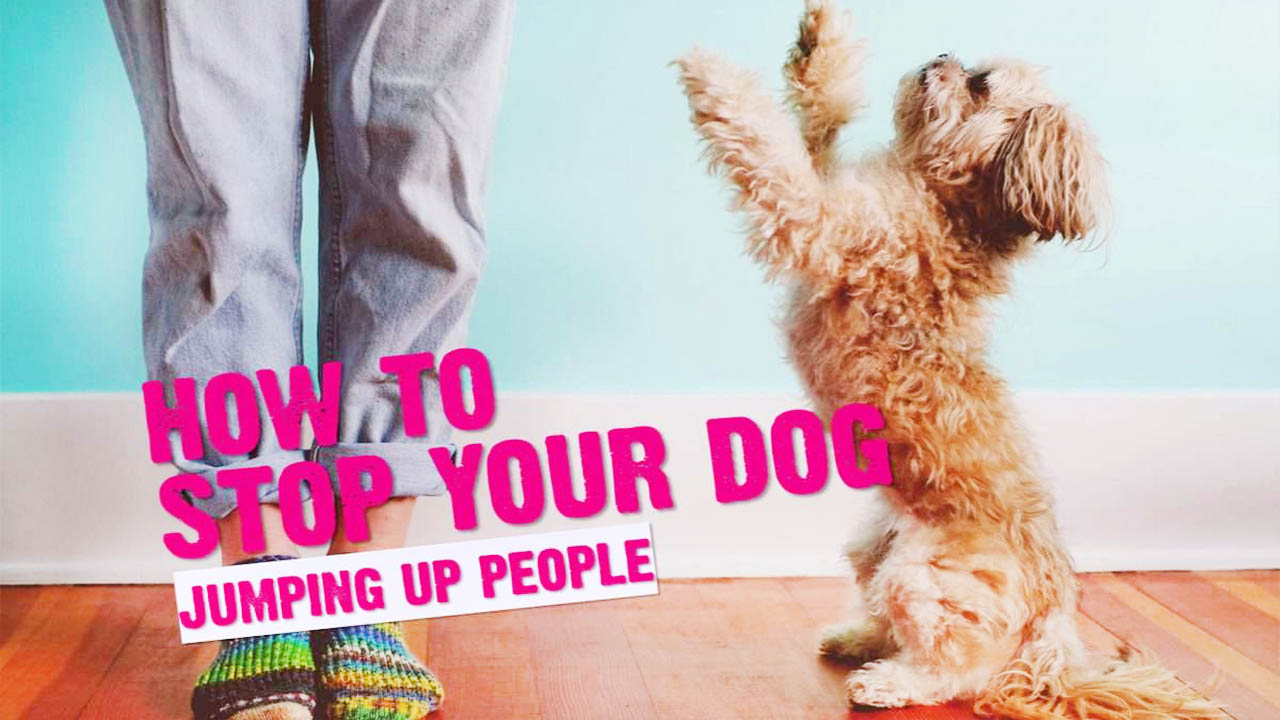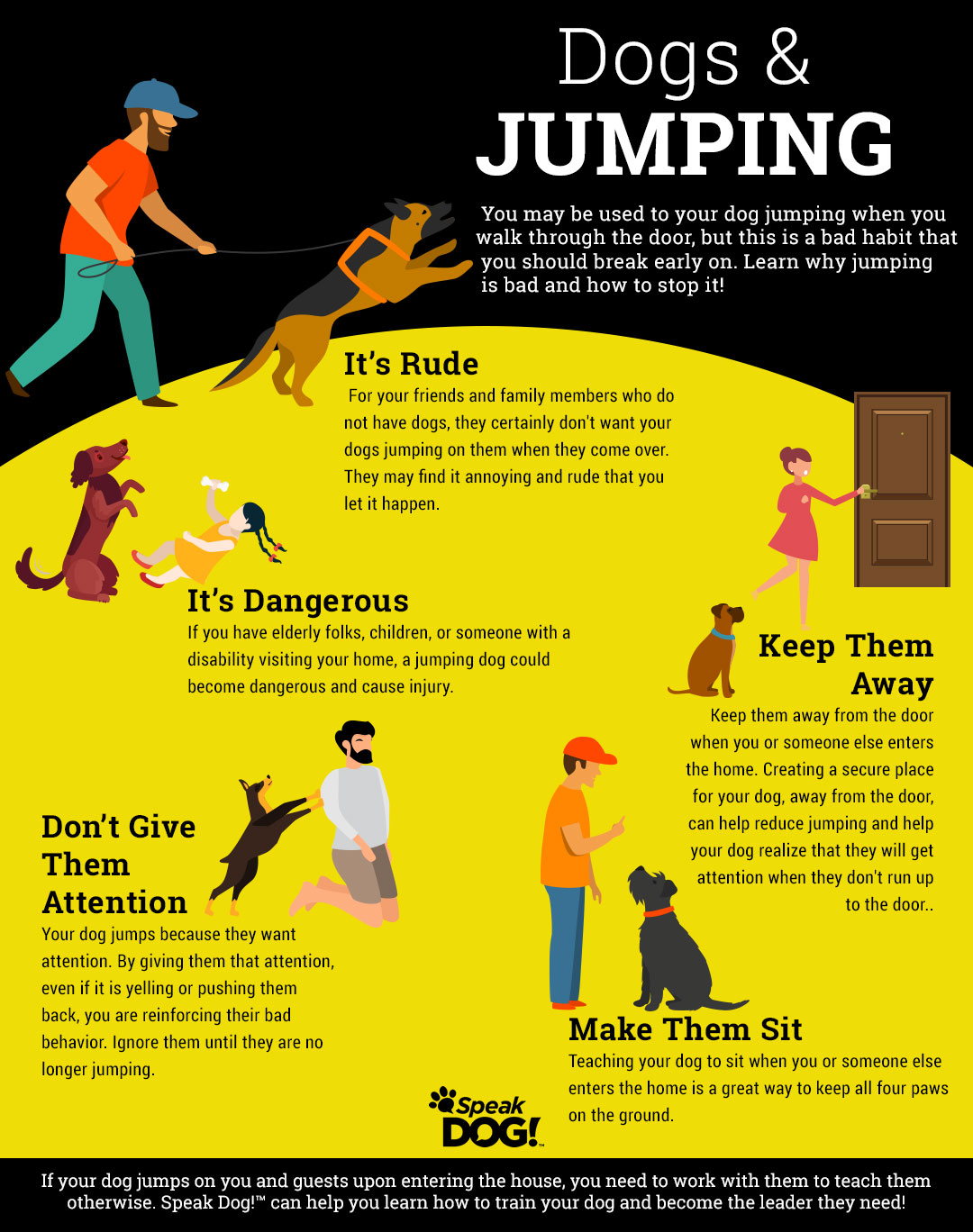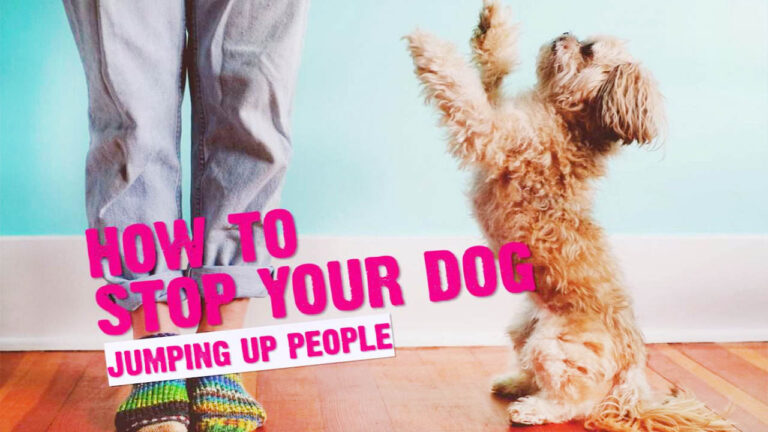To train a dog not to jump on people, consistently use the “off” command and reward with treats when they obey. Redirect their attention to a toy or a command to sit whenever they try to jump.
Training a dog not to jump on people is essential for their safety and the comfort of others. It requires consistent reinforcement of the “off” command and redirection of their attention to more appropriate behaviors. It’s important to reward the dog with treats when they obey and to remain patient and consistent throughout the training process.
By setting clear boundaries and providing positive reinforcement, you can effectively teach your dog to greet people in a calm and controlled manner, ensuring a more pleasant interaction for everyone involved.

Understanding The Issue
Jumping on people can be an irritating habit that many dogs develop. Although their intention is usually friendly, it can be overwhelming and even dangerous, especially when dealing with larger dogs. It is important to understand the root causes behind this behavior and the impact it can have on both people and the dog. By gaining a deeper understanding of the issue, we can develop effective training strategies that will help prevent jumping and ensure harmonious interactions between our furry friends and the people they encounter.
Causes Of Jumping Behavior
Several factors contribute to a dog’s inclination to jump on people. Understanding these causes is essential when undertaking training to modify this behavior. Here are some common reasons behind jumping:
- Excitement: Dogs often jump as a way to express their enthusiasm and greet people.
- Seeking attention: Jumping can be a dog’s way of getting noticed or seeking interaction from their owners or visitors.
- Untrained behavior: Dogs may jump simply because they haven’t been taught proper greeting manners.
- Fear or anxiety: Some dogs may jump as a result of feeling uncomfortable, fearful, or anxious in certain situations or around new people.
Identifying the underlying cause of your dog’s jumping behavior is crucial to addressing the issue effectively. Once we understand why they jump, we can tailor our training methods accordingly.
Impact On People And The Dog
While it may seem harmless at first, persistent jumping can negatively impact both people and the dog. Here are some consequences to consider:
| Impact on People | Impact on the Dog |
|---|---|
|
|
Recognizing the impact jumping has on both parties involved emphasizes the importance of addressing this behavior early on. By teaching dogs appropriate ways to greet people, we can ensure a safer and more enjoyable experience for everyone.

Credit: speakdog.com
Establishing Boundaries
When it comes to training your dog not to jump on people, establishing boundaries is crucial. By setting clear rules, you can teach your dog the appropriate behavior when greeting others.
Teaching ‘off’ Command
Teaching your dog the ‘off’ command is an effective way to discourage jumping. When your dog jumps, firmly say “off” and gently push them away. This action reinforces the idea that jumping is not acceptable. Consistency is important; make sure everyone in the household uses the same command and approach.
Using Positive Reinforcement
Positive reinforcement is key to training your dog not to jump on people. When your dog greets someone without jumping, reward them with treats and praise. This encourages the desired behavior and helps your dog understand what is expected of them.
Redirecting Energy
Redirecting your dog’s energy is an essential part of training them not to jump on people. By providing alternative behavior and engaging in physical activities, you can redirect your dog’s energy towards positive and appropriate actions. This helps to discourage jumping and encourages good behavior in your dog.
Providing An Alternative Behavior
When your dog is prone to jumping, it’s crucial to provide them with an alternative behavior to replace the jumping. Teach your dog to greet people by sitting calmly. Please give them a treat when they sit instead of jumping. Consistency is key – make sure not to reward them if they jump up. This will help them understand that sitting is the behavior you expect from them when greeting people.
Engaging In Physical Activities
Regular physical exercise is vital for a dog’s overall well-being. Engaging in physical activities such as daily walks, playing fetch, or running around in the yard can help release excess energy, making them less likely to jump on people out of excitement. A well-exercised dog is often a well-behaved dog.

Credit: m.youtube.com
Managing Greetings
Train your dog to greet people calmly by teaching them to refrain from jumping. Use positive reinforcement techniques such as rewards and consistent training to help your dog understand appropriate greetings.
Creating A Calm Environment
To effectively manage greetings and prevent your dog from jumping on people, it is important to create a calm environment. Dogs are sensitive to their surroundings, so a peaceful atmosphere can help set the right tone for controlled interactions.
- Ensure that your dog is in a calm state of mind before any greetings occur.
- Take your dog for a walk or engage in some playtime to release excess energy.
- Consider using a leash or a designated area to provide structure and limit their movement during greetings.
- Remain calm and be a positive role model by showing relaxed body language.
- Teach your dog a solid “stay” or “wait” command to help them remain calm and in place during greetings.
Reinforcing Good Behavior During Greetings
Positive reinforcement is key to training your dog not to jump on people. By rewarding good behavior, you can help your dog understand what is expected of them during greetings. Consistency and patience are crucial in reinforcing their training.
- When greeting your dog, encourage them to sit or remain in a calm position.
- Use treats or praise to reward them for staying calm and not jumping.
- Offer alternative behaviors, such as sitting or shaking hands, that redirect your dog’s excitement during greetings.
- Consistently reinforce the desired behavior by rewarding them each time they remain calm during greetings.
- Avoid punishment or yelling, as this can confuse and intimidate your dog.
Seeking Professional Help
Training a dog not to jump on people can be a challenging task, especially if you have tried various methods without success. In such cases, seeking professional help can prove to be the most effective solution. Bringing in a certified dog trainer can make a world of difference in addressing your dog’s jumping behavior. These experts have the knowledge and experience to assess the situation and develop an appropriate training plan.
A professional dog trainer will begin by understanding the underlying reasons behind your dog’s jumping behavior. They will evaluate your dog’s temperament, and previous training, and observe their body language to get a clear understanding of the issue. Often, dogs jump on people to seek attention, display excitement, or even as a sign of anxiety. A skilled dog trainer will identify these underlying issues and include them in the training plan.
The training sessions will focus on teaching your dog alternative behaviors that are more desirable and suitable for social interactions. These may include sitting, staying calm, or approaching people with permission. Addressing any underlying issues is paramount to ensure long-term success. A professional trainer will work with you to reinforce positive behaviors and eliminate the jumping habit gradually.
Remember that training takes time and consistency. Be patient and follow the trainer’s guidance to see progress. Through regular training sessions and ongoing support, your dog will gradually learn to curb their jumping habit.

Credit: www.akc.org
FAQ Of Train Dogs Not To Jump On People
How Do I Teach My Dog Not To Jump On People?
To teach your dog not to jump on people, start by ignoring them when they jump and only give attention when they have all four paws on the ground. Use positive reinforcement training techniques, such as treats and praise, to reward good behavior and redirect them to an appropriate behavior, like sitting or lying down.
Why Does My Dog Jump On People?
Dogs may jump on people to seek attention, show excitement, or display dominance. It is important to address this behavior as it can be intimidating and potentially harmful. By understanding the reasons behind jumping and implementing consistent training techniques, you can teach your dog more appropriate ways to engage with people.
How Can I Prevent My Dog From Jumping On Guests?
To prevent your dog from jumping on guests, start by training them to sit or stay when someone enters the house. Use positive reinforcement to reward them for calm behavior. Gradually increase the difficulty level by having guests practice entering and exiting while your dog remains calm. Consistency, patience, and proper socialization will help your dog learn appropriate greeting behaviors.
Conclusion
To sum up, training your dog not to jump on people requires consistency, patience, and positive reinforcement. By setting clear boundaries and redirecting their behavior, you can teach them appropriate greetings. Remember to reward good behavior and discourage jumping with calm assertiveness.
With time and consistency, your dog will learn to greet people politely, making interactions enjoyable for everyone involved. Happy training!



